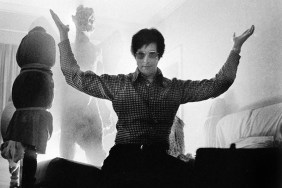
You know what feels good? Abundance.
2014 is tapering off and as the year-enders start to flow, I find difficulty in narrowing mine down. More than that, I find no reason to. For genre be it horror, or what weve co-opted as such (nothing wrong with that!) 2014 was a year with breadth and variety. Sure, recurring themes, mini-motifs and possible doub features present themselves: terror of domesticity, vampire hangouts, sheen-synth Carpenter scores (and sheen-synth Carpenter action), microbudget contained anxiety and spellbinding art-horror spectacle, for instance. Still, the films contained within are indicative of new, singular, vastly different, evolving voices; and thats not to mention the several 2015 releases already deserving of top spots. Thats exciting. Thatll make you feel good. Even if some of the films themselves, wont.
Here then, are the best horror films of the year. There are 15, and outside of my absolute number-one (listed at the top), they are presented in the only order that makes sense: alphabetical. Ranking, particularly midst celebration, seems fruitless.
The Babadook (dir. Jennifer Kent)

For two years in a row, I was fortunate to catch what would be my favorite film very early on. Last January, on the first midnight of the Sundance Film Festival, The Babadook blew me away. Artfully constructed with frightening shadowplay and nods to expressionist cinema, while being earnest and refreshingly honest in its themes, The Babadook feels simultaneously classical and invigorating; at once an all-timer and the debut of a bold new filmmaker. Director Jennifer Kent, together with tremendous stars Essie Davis and Noah Wiseman, confronts the realities of troubled a parent-child relationship, the guilt and grief that can eat away at and obstruct unconditional love. Kent does as much with a devastating story as she does with a malevolent, playful spirit, embodied by the immediately haunting figure of The Babadook, this storybook Coffin Joe by way of Edward Gorey creation. Whats more, Kent reveals herself as the real deal by keeping The Babadook a horror film, and one about facing, understanding and balancing the horror in our lives by the horror stories we tell.
At The Devils Door (dir. Nicholas McCarthy)

Nicholas McCarthy makes choices. He twists and turns and without the standard reveals or shocking twists weve come to expect. In second feature At The Devils Door, he quite actively changes course. A sort-of omnibus, Devils Door sees three young women and their desires and aspirations exploited and impeded by Satan. The film is cut into three chunks, often jarring the audience by revealing there isnt exactly a protagonist. What there is, is atmosphere. Stirring images that facilitate sometimes deliberate, sometimes totally absurd dread. Ashley Rickards vacant, violent stare outside of a suburban house party, the former; Naya Rivera literally (and topically) being told to not speak and have a child, the latter. In the middle is the sadder affair of Catalina Sandino Moreno, as well as finely composed old-school shocks. It makes for one strange, alluring beast.
The Canal (dir. Ivan Kavanagh)

The Canal is fucking ghastly. Conscious and incorporating of cinematic history, Ivan Kavanaghs Irish shocker plays as dread-filled portrait of vicious cycle and inevitability: we tell domestic horror stories, because domestic horror stories happen. In the film, a cinema archivist with suspicions of infidelity and fear of inadequacy is spurred on by footage of an early 20th century crime scene, a disturbing family murder that happened in his very home. Soon, Davids wife is missing and he has a haunting figure to blame. The question is never who did it, but how far Davids descent will go, and whether a long dead maniac who murdered his own family is supernaturally responsible for influencing Davids actions, or whether Davids simply lost it on his own is moot. Kavanagh visually articulates Davids parental and masculine anxiety expertly (along with editor Robin Hill), and then stunningly proceeds to traverse horror aesthetics and atmosphere, from paranoid tension to all-out grotesque imagery. Its genuinely upsetting, and was unfortunately overlooked. Heres to audiences rectifying such in the New Year. [Note: While Shock Till You Drop did indeed have a hand in The Canals release, it was months before my position took effect. Additionally, I saw and reviewed the film glowingly at Fangoria upon its premiere at the Tribeca Film Festival and before its distribution was set.]
Cheap Thrills (dir. E.L. Katz)

Cheap Thrills is so biting in its contained depiction of societal illsclassism, how money corrupts, how friendships dissolve, how we enjoy the debasement of our fellow manbut its so hilarious and so devastating, as well. Like Kent, E.L. Katzs feature debut is a tremendous, and terrifically human one. The ensemble (Pat Healy, Ethan Embry, David Koechner and Sara Paxton) conveys and embodies the emotional see-saw, while Katz captures it in raw, but assured manner. From my review: His camera is the handheld of a low-budgeted feature, but mannered for maximum effect. The chaos of an untethered and ill-advised shaky-cam is eschewed for something with actual verisimilitude where the fact that these connecting characters do such things to each other and themselves is the real shock/surprise/fright/joke. Theres a good deal of flourish, too. Framing the early scenes in the cheap red of that dive bar is foreboding, and while instances of close-up dont have Craig or Vince break the fourth wall, they still do read as uncomfortably confrontational. Later, some of the best moments come when Katz lets scenes play out with full view of those in backgrounds and corners. Its a small cast, yes, but their looks, asides, whispers and texts across a living room create a nervous energy, like Craig is alone in a crowd. Equally grin and wince-inducing, you could say CHEAP THRILLS has its cake and devours it too, by both reveling in and mocking our love of others misfortunes and anything-to-get-by rationalization, but really, that just makes it more of a subversive reflection.
Coherence (dir. James Ward Byrkit)

Similarly contained, similarly anxious and similarly revealing of our wants and perceptions, James Ward Byrkits heady dinner party sci-fi thriller Coherence is one of the best films of the year. Largely improvised (according to an outline and structure) over five nights and shot in sequence, Coherence feels like achievement. Its too tight, too viscerally thrilling for such a shoestring and deceptively loose production. The film sees eight friends meet for a dinner party on the night of a comets passing. As such, it creates a supernatural event and when the power goes out, a lonely, brightly lit home down the street reveals the same gatheringdoppelgangers. Though using Schrodingers Cat and Quantum Theory as catalysts, Coherence is far more about how we perceive or idealize our friendships, as well as the journey of Em (Emily Baldoni) throughout its phenomena. Defined by dissatisfaction and haunted by indecision, Em attempts to take control of Coherences otherworldly revelations in startling manner, arriving at a place of sad reality.
Cold in July (dir. Jim Mickle)

Jim Mickle gets better and better. 2013s We Are What We Are was pitch-perfect American Gothic about familial and American tradition. In 2014, he went south for one of the best and most purely entertaining genre films of the year: Cold in July. Writing with frequent partner Nick Damici and basing their script on the work of another genre great, Joe R. Lansdale, Cold in July is tough shit. Its a sweaty Texas noir; a gaze-into-abyss men-on-a-mission thats beefed up by an unexpected twist, gristly action, a delightful turn from Don Johnson and a stunner of a synth score from Jeff Grace. It pops like a can of beer.
A Field in England (dir. Ben Wheatley)

I think Ben Wheatley is the most exciting filmmaker going. His work is playful, scary, stylish and darkly funny. Its both immediate and grand, and while the films are ultimately different, they all manage to take on a primal, ancient air. Here, he engages directly with that, crafting a surreal, pagan period piece wholly enrapturing and unexpected on first view, and which subsequently unfurls upon return. Presented as a film of magic and madness, it is also one of many possibilities, from vastly different interpretation to whether or not one will view it as informed by everything the directors created until now. For those that do, it seems absolutely a culmination, one that allows the overspill of mystical air and dark energy thats hung over, both heavily and not, Down Terrace, Kill List and Sighteers. Whats more, A Field in England is truly weird. Its psychotropic imagery plays as spectacle, but musical interludes, painterly tableaus and harsh sound design really amp the offsetting vibe.
A Girl Walks Home Alone at Night (dir. Ana Lily Amirpour)

2014s most swooning film is another stirring debut. A Girl Walks Home Alone at Night is a black-and-white disco ball exploding, revealing director Ana Lily Amirpours brain. Her cultural influences (film, music, heritage) dance together in a tale both cinematic in anamorphic construct and because its setting and characters can only live onscreen. Amirpour, vampires, Lynchian cool, feminism, Sergio Leone cues, post punk and Iran converge in a story of convergence. Converging and connecting are key, and in the eyes of Amirpour, very, very cool.
The Guest (dir. Adam Wingard)

If Cold in July is the most purely entertaining genre film of the year, The Guest is the most exhilarating. Both films take Carpenter cues, but transcend any sort of reference or homage to 80s feel, and create a state of mind. Adam Wingard and Simon Barrett craft another sharp, menacing, funny tale of mistrust and concealment (this time with government parallel), but push style and action even further into top notch B-movie spectacle. Dan Stevens deliberate performance is one of the most essential of the year, and thats not to mention a terrific supporting ensemble including Brendan Meyer, Maika Monroe and Leland Orser. It all leads to this purely cinematic finale, one of light and sound and breath and death. The Guest only improves on each subsequent view; it is as endlessly rewatchable as its soundtrack is playable.
Housebound (dir. Gerard Johnstone)

Again, with the feature debuts. Was there a bigger surprise than Housebound? Director Gerard Johnstones New Zealand horror-comedy slays on every one of its levels, from haunted house mystery, to bratty coming-of-adulthood, to mother-daughter film, to splatstick comedy. Its star Morgana OReilly is just that, an irresistible screen presence with the greatest reaction faces onscreen in 2014. And its all set within a creaky, fantastic old structure. I love this film, and its a shame most viewers wont experience it with an audience.
Only Lovers Left Alive (dir. Jim Jarmusch)

This year, vampires returned in stunning alt form. Jim Jarmusch and his no-wave, rock n roll forever cool contemplated the endurance of immortality, embodied by a mopey Tom Hiddleston; a centered, love-filled Tilda Swinton; a delightful John Hurt; and Mia Wasikowska-as-Juno Temple. Its a fantastic hang, one that revels in and pokes fun at the archetypal, lovesick and world weary creature and features the gift of Jeffrey Wright. Jarmusch lushly juxtaposes Tangier and Detroit, punctuating the atmosphere with an alluring musical detour, and just a bit of bloodletting.
Starry Eyes (dir. Kevin Kölsch & Dennis Widmyer)

The Strange Color of Your Bodys Tears (dir. Hélène Cattet & Bruno Forzani)

Ostensibly, The Strange Color of Your Bodys Tears has a more linear plot than Cattet & Forzanis experimental anthology Amer. But the surreal, fetishistic gialli stylings of the filmmakers are pushed even further into a stunning piece of work thats transfixing, upending and relentless in its pursuit of a kaleidoscopic altered state. This is not for the unadventurous, or those who dont fancy themselves a fan of what Cattete & Forzani are up to. Youll feel weird supreme on Strange Colors end, and thats one of the many reasons its one of my favorite films of the year.
The Town That Dreaded Sundown (2014; dir. Alfonso Gomez-Rejon)

Each year, each era has its overlooked horror filmsminor thrillers with moments of stylish titillation, or strange ideas. For a long time, Charles B. Pierces 1976 idiosyncratic horror docudrama The Town That Dreaded Sundown was one and now, in a present VOD market bombarded with titles, I believe its nutty remake might be in the same boat. The feature debut of Alfonso Gomez-Rejon, whose indulgent style often carries American Horror Story when plot cannot, The Town That Dreaded Sundown (2014) is rooted in the self-referencing ending of Pierces original, all-out De Palma flair and meta, knowing post-Scream slashers. The film lives in some amalgamation of reality and heightened style. Yes, the original picture about the true-life Texarkana Moonlight Murders plays in Texarkana annually, and so its premise is both grounded and metatextual. The former, its imagery is not. Rejon goes nuts with sweeping cameras, diopter shots, big color and a mean spirit as a new Phantom Killer takes Texarkana by storm. The filmmaker isnt visually creative with just murder however, playing with Texarkanas border location and the regions two police forces. And then theres Anthony Anderson, going big as dick-swinger Lone Wolf Morales, a character I want partnered with Cold in Julys Jim Bob (Don Johnson) for a ten gallon buddy comedy.
Under the Skin (dir. Jonathan Glazer)

Many of this years best films come in tandem with the best scores. Mica Levis severe accompaniment to Under the Skin is already celebrated, and of course appropriated, and it perfectly captures the confounding, unnerving nature of Jonathan Glazers art-horror showstopper. In both its otherworldly spaces and its natural landscapes (composed to feel otherworldly), Under the Skin is breathtaking. The world surrounding Scarlett Johansson often feels integral to theme as her inquisitive extraterrestrial seems more at peace out in the country than the harsh, often closely shot urban environments where she lulls prey. And thats what I saw, a story of nature, its levels and the defilement of its highest planes.
And for fun, Id love to note that outside of the genre, some of my favorites included Ida, Force Majeure, Citizenfour, Gone Girl, God Help the Girl, Starred Up and Locke.









